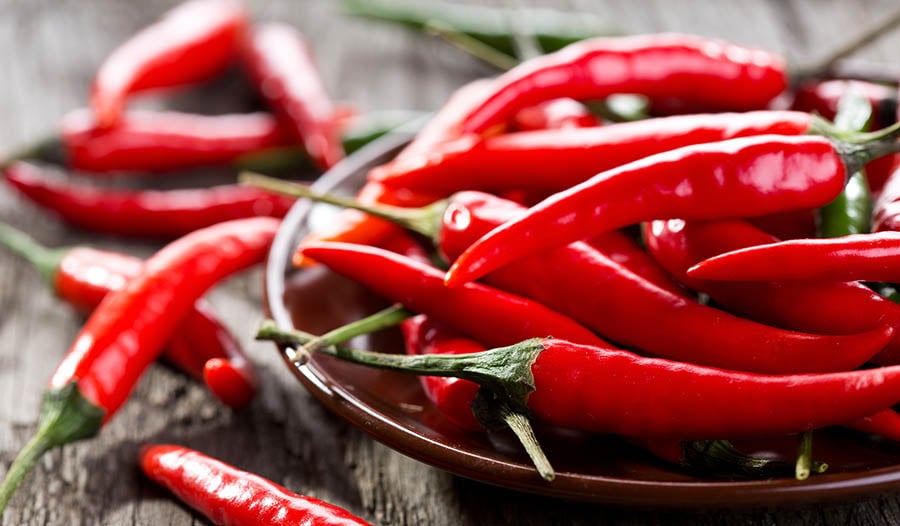4 Capsaicin Health Benefits: Pain, Digestion, and More
DISCLAIMER:This blog does not intend to provide diagnosis...
- In this article:
- 1. Capsaicin and Pain Relief Benefits
- 2. Capsaicin and Digestive Benefits
- 3. Capsaicin and Cardiovascular Benefits
- 4. Capsaicin and Weight-Management Benefits
- How to Use Cayenne

Originally Posted February 2019 / Updated February 2023
Cayenne pepper comes from the fruit of Capsicum annuum/longum, which is a shrubby tropical plant. The spice pepper of cayenne can vary from mild, like paprika, to very hot and spicy. The determining factor is the content of capsaicin. The higher the capsaicin level, the greater it is hot and spicy.
One of the exciting effects of capsaicin is that while it is hot to the taste, it lowers body temperature by stimulating an area in the brain referred to as the “cooling center.” Since capsicum species are tropical plants, nature seems to provide a way for people living in the tropics to get relief from high temperatures. And even though it promotes heat loss, Capsicum activates thermogenesis without raising core temperatures.1
1. Capsaicin and Pain Relief Benefits
Capsaicin has been intensely studied for decades. Capsaicin-containing creams and gels are FDA-approved for relieving arthritis, the pain of the after-effects of shingles (post-herpetic neuralgia), and diabetic neuropathy.2
When capsaicin is applied to the skin or ingested, it causes nerve cells to release substance P (the “P” stands for pain). The immediate response results in irritation, but repeated applications of capsaicin deplete the substance P from nerve fibers. As a result, repeated use leads to blocking the pain sensation.
When ingested repeatedly, a tolerance develops. In other words, the more red pepper you eat, the less spicy it becomes. It may be nature’s way to help you maximize the health benefits. And here is another exciting thing that happens with frequent ingestion of spicy foods. It activates a brain center that triggers the craving for spicy foods. When subjects that crave spicy foods were shown pictures of them, it led to increased activation of neural pathways and brain areas associated with natural rewards, food cravings, and drug addictions.3 The brain wave patterns of spicy food cravers also showed some interesting aspects that suggest improved brain activity. Other studies show several mechanisms whereby the consumption of spicy foods helps to preserve brain function with aging.4
2. Capsaicin and Digestive Benefits
Eating spicy foods stimulates and enhances digestion. This effect was shown in a study published in the New England Journal of Medicine. Researchers found that doses of red pepper (2.5 grams before meals) significantly reduced indigestion symptoms in people dealing with frequent indigestion. In the group receiving red pepper before meals, their symptoms of indigestion (nausea, stomach pain, bloating, and overall symptom scores were about 50% lower compared to the placebo group.5
Interestingly, many people avoid spicy foods thinking they aggravate stomach irritation, but clinical studies show otherwise. Clinical research has shown that red pepper consumption protects against stomach damage, improves abdominal pain, feelings of fullness, and nausea scores in people with stomach irritation, and improves symptoms of irritable bowel syndrome.6-8
The above said, there is no question that some people are bothered by cayenne pepper ingestion. The good news is that if they start with milder forms of red pepper, like paprika, and start building up a tolerance, eventually, there will achieve the beneficial effects of capsaicin on the stomach lining.
3. Capsaicin and Cardiovascular Benefits
Cayenne pepper also exerts beneficial effects on the heart and blood vessels. It possesses several actions that prevent atherosclerosis or hardening of the arteries.9 A capsaicin-rich diet reduces blood cholesterol and triglyceride levels.10 But its protective benefits go well beyond these effects. Capsaicin increases fibrinolytic activity, which can prevent the formation of blood clots that can lead to a heart attack or stroke.11 This effect may explain why cultures eating a diet rich in cayenne pepper have much lower heart attacks and stroke rates.
4. Capsaicin and Weight-Management Benefits
A capsaicin-rich diet exerts many beneficial effects in supporting weight management. Increasing the intake of cayenne pepper may increase the basal metabolic rate and fat burning. Clinical studies have shown that adding hot peppers to your diet is a safe, natural way to enhance metabolism and the burning of fat for energy and improve blood sugar control.12-14
How to Use Cayenne
Cayenne peppers are available whole, fresh, dried, flaked, or ground into a powder. Ground cayenne pepper and paprika can be kept for up to one year in sealed glass jars away from direct sunlight.
Here are some suggested uses to get more capsaicin in your diet:
- Keep a container of crushed or ground cayenne pepper on the table to add to food as desired.
- Add a pinch of cayenne pepper to hot cocoa to give it a spicy flair.
- A simple dash of cayenne pepper added to any food adds a little spice.
- Add ¼ tsp of cayenne pepper and two tablespoons of lemon juice, then stir into three cups of cooked greens such as collard, mustard greens, or kale.
References:
- Kobayashi A, Osaka T, Namba Y, Inoue S, Lee TH, Kimura S. Capsaicin activates heat loss and heat production simultaneously and independently in rats. Am J Physiol. 1998 Jul;275(1):R92-8.
- Ilie MA, Caruntu C, Tampa M, Georgescu SR, Matei C, Negrei C, Ion RM, Constantin C, Neagu M, Boda D. Capsaicin: Physicochemical properties, cutaneous reactions and potential applications in painful and inflammatory conditions. Exp Ther Med. 2019 Aug;18(2):916-925.
- Zhou Y, Gao X, Small DM, Chen H. Extreme spicy food cravers displayed increased brain activity in response to pictures of foods containing chili peppers: an fMRI study. Appetite. 2019 Nov 1;142:104379.
- Tyagi S, Shekhar N, Thakur AK. Protective Role of Capsaicin in Neurological Disorders: An Overview. Neurochem Res. 2022 Jun;47(6):1513-1531.
- Bortolotti M, Coccia G, Grossi G. Red pepper and functional dyspepsia. N Engl J Med 2002;346:947–8.
- Gonzalez R, Dunkel R, Koletzko B, et al. effect of capsaicin-containing red pepper sauce suspension on upper gastrointestinal motility in healthy volunteers. Dig Dis Sci 1998;43(6):1165-71.
- Rodriguez-Stanley S, Collings KL, Robinson M, Owen W, Miner PB Jr. The effects of capsaicin on reflux, gastric emptying and dyspepsia. Aliment Pharmacol Ther 2000;14(1):129-34.
- Bortolotti M, Porta S. Effect of red pepper on symptoms of irritable bowel syndrome: preliminary study. Dig Dis Sci. 2011 Nov;56(11):3288-95.
- Szallasi A. Dietary Capsaicin: A Spicy Way to Improve Cardio-Metabolic Health? Biomolecules. 2022 Nov 29;12(12):1783.
- Sambaiah K, Satyanarayana MN. Hypocholesterolemic effect of red pepper & capsaicin. Indian J Exp Biol 1980;18(8):898-9.
- Visudhiphan S, Poolsuppasit S, Piboonnakarintr O, and Tumliang S: The relationship between high fibrinolytic activity and daily capsicum ingestion in Thais. Am J Clin Nutr 1982;35:1452-8.
- Zheng J, Zheng S, Feng Q, Zhang Q, Xiao X. Dietary capsaicin and its anti-obesity potency: from mechanism to clinical implications. Biosci Rep. 2017 May 11;37(3):BSR20170286.
- Nieman DC, Cialdella-Kam L, Knab AM, Shanely RA. Influence of red pepper spice and turmeric on inflammation and oxidative stress biomarkers in overweight females: a metabolomics approach. Plant Foods Hum Nutr. 2012 Dec;67(4):415-21.
- Ahuja KD, Robertson IK, Geraghty DP, Ball MJ. Effects of chili consumption on postprandial glucose, insulin, and energy metabolism. Am J Clin Nutr. 2006 Jul;84(1):63-9.

 By Dr. Michael Murray, N.D.
By Dr. Michael Murray, N.D. 


